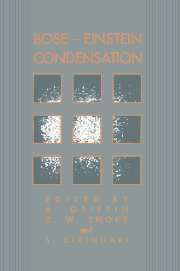Book contents
- Frontmatter
- Contents
- Preface
- Preface to paperback edition
- 1 Introduction: Unifying Themes of Bose–Einstein Condensation
- Part one Review Papers
- Part two Brief Reports
- 20 BEC in Ultra-cold Cesium: Collisional Constraints
- 21 BEC and the Relaxation Explosion in Magnetically Trapped Atomic Hydrogen
- 22 Quest for Kosterlitz–Thouless Transition in Two-Dimensional Atomic Hydrogen
- 23 BEC of Biexcitons in CuCl
- 24 The Influence of Polariton Effects on BEC of Biexcitons
- 25 Light-Induced BEC of Excitons and Biexcitons
- 26 Evolution of a Nonequilibrium Polariton Condensate
- 27 Excitonic Superfluidity in Cu2O
- 28 On the Bose–Einstein Condensation of Excitons: Finite-lifetime Composite Bosons
- 29 Charged Bosons in Quantum Heterostructures
- 30 Evidence for Bipolaronic Bose-liquid and BEC in High-Tc Oxides
- 31 The Dynamic Structure Function of Bose Liquids in the Deep Inelastic Regime
- 32 Possibilities for BEC of Positronium
- 33 Bose–Einstein Condensation and Spin Waves
- 34 Universal Behaviour within the Nozières–Schmitt-Rink Theory
- 35 Bound States and Superfluidity in Strongly Coupled Fermion Systems
- 36 Onset of Superfluidity in Nuclear Matter
- Appendix. BEC 93 Participant List
- Index
32 - Possibilities for BEC of Positronium
Published online by Cambridge University Press: 15 December 2009
- Frontmatter
- Contents
- Preface
- Preface to paperback edition
- 1 Introduction: Unifying Themes of Bose–Einstein Condensation
- Part one Review Papers
- Part two Brief Reports
- 20 BEC in Ultra-cold Cesium: Collisional Constraints
- 21 BEC and the Relaxation Explosion in Magnetically Trapped Atomic Hydrogen
- 22 Quest for Kosterlitz–Thouless Transition in Two-Dimensional Atomic Hydrogen
- 23 BEC of Biexcitons in CuCl
- 24 The Influence of Polariton Effects on BEC of Biexcitons
- 25 Light-Induced BEC of Excitons and Biexcitons
- 26 Evolution of a Nonequilibrium Polariton Condensate
- 27 Excitonic Superfluidity in Cu2O
- 28 On the Bose–Einstein Condensation of Excitons: Finite-lifetime Composite Bosons
- 29 Charged Bosons in Quantum Heterostructures
- 30 Evidence for Bipolaronic Bose-liquid and BEC in High-Tc Oxides
- 31 The Dynamic Structure Function of Bose Liquids in the Deep Inelastic Regime
- 32 Possibilities for BEC of Positronium
- 33 Bose–Einstein Condensation and Spin Waves
- 34 Universal Behaviour within the Nozières–Schmitt-Rink Theory
- 35 Bound States and Superfluidity in Strongly Coupled Fermion Systems
- 36 Onset of Superfluidity in Nuclear Matter
- Appendix. BEC 93 Participant List
- Index
Summary
Abstract
We review the proposal for Bose–Einstein condensation of positronium atoms. All of the ingredients necessary to achieve BEC of Ps atoms are currently available.
Introduction
In this volume several authors have discussed and described a variety of weakly interacting systems which might display BEC. In this short contribution we suggest that a dense gas of positronium (Ps) atoms in vacuum is a rather ideal but somewhat more exotic system that might be a very good candidate for observing a weakly interacting BEC.
Recent investigations of the interactions of positrons (e+) and (Ps) with solids have led to extraordinary improvements in the kinds of low energy experiments we can do with the positron [1, 2]. All of the ingredients necessary to achieve BEC of Ps atoms are currently available. We envision a scenario where roughly N ≅ 105 Ps atoms are trapped in a volume v ≃ 10−13 cm3 and allowed to cool through the Bose transition temperature of 20 – 30K in a time of the order of nanoseconds. In the following we discuss the relevant interactions and describe how Ps BEC can be achieved.
Single Positronium Physics
Ps is comprised of an e+ − e− bound in a hydrogenic orbit. Its mass, 2me, is extremely light compared to H, an important ingredient for achieving reasonable Bose condensation temperatures. Its binding energy (6.8 eV) is half that of H.
- Type
- Chapter
- Information
- Bose-Einstein Condensation , pp. 558 - 564Publisher: Cambridge University PressPrint publication year: 1995
- 1
- Cited by

